Extragalactic Astrophysics

We are the extragalactic astrophysics group. Our research is centered around the following topics:
- high-energy astrophysics
- particle acceleration and plasma physics
- clusters of galaxies
- active galactic nuclei
- radio astronomy
- machine learning
CURRENT POSITION
Since 2012 Full Professor of Extragalactic Astrophysics
EDUCATION
1999 PhD
Institute of Astronomy, University of Cambridge, United Kingdom
1995 BA/MA
University of Cambridge, United Kingdom
PREVIOUS POSITIONS
2006 – 2012 Associate Professor of Astrophysics
Jacobs University Bremen, Germany
2001 – 2006 Assistant Professor of Astrophysics
Jacobs University Bremen, Germany
1999 – 2000 Postdoctoral Researcher
Max-Planck Institute for Astrophysics, Garching, Germany
1999 – 2001 Junior Research Fellow
Churchill College, University of Cambridge, United Kingdom
MEMBERSHIPS OF SCIENTIFIC SOCIETIES AND COMMISSIONS OF TRUST
since 2022 Member of the Scientific Advisory Council of the Leibniz-Institut für Astrophysik Potsdam (AIP)
since 2022 Member of eROSITA (space mission) Steering Committee
since 2021 Panel Chair Astrophysics for the Leibniz-Rechenzentrum (LRZ), Munich
since 2020 Chair of Advisory Board of Thuringian State Observatory
2017 Scientific Advisory Board, University of Cologne, Germany
2016-2020 Chairman, German Long Wavelength Consortium (GLOW) https://www.glowconsortium.de
2016-2020 Member of DFG Grants Committee Astronomy (Fachkollegium Astronomie)
since 2016 Executive Committee Council of German Observatories (Rat Deutscher Sternwarten)
since 2010 Core Team of LOFAR Surveys Key Science Project
2010-2016 – German representative on Executive Board International LOFAR Telescope
since 2015 Executive Board 4MOST instrument consortium
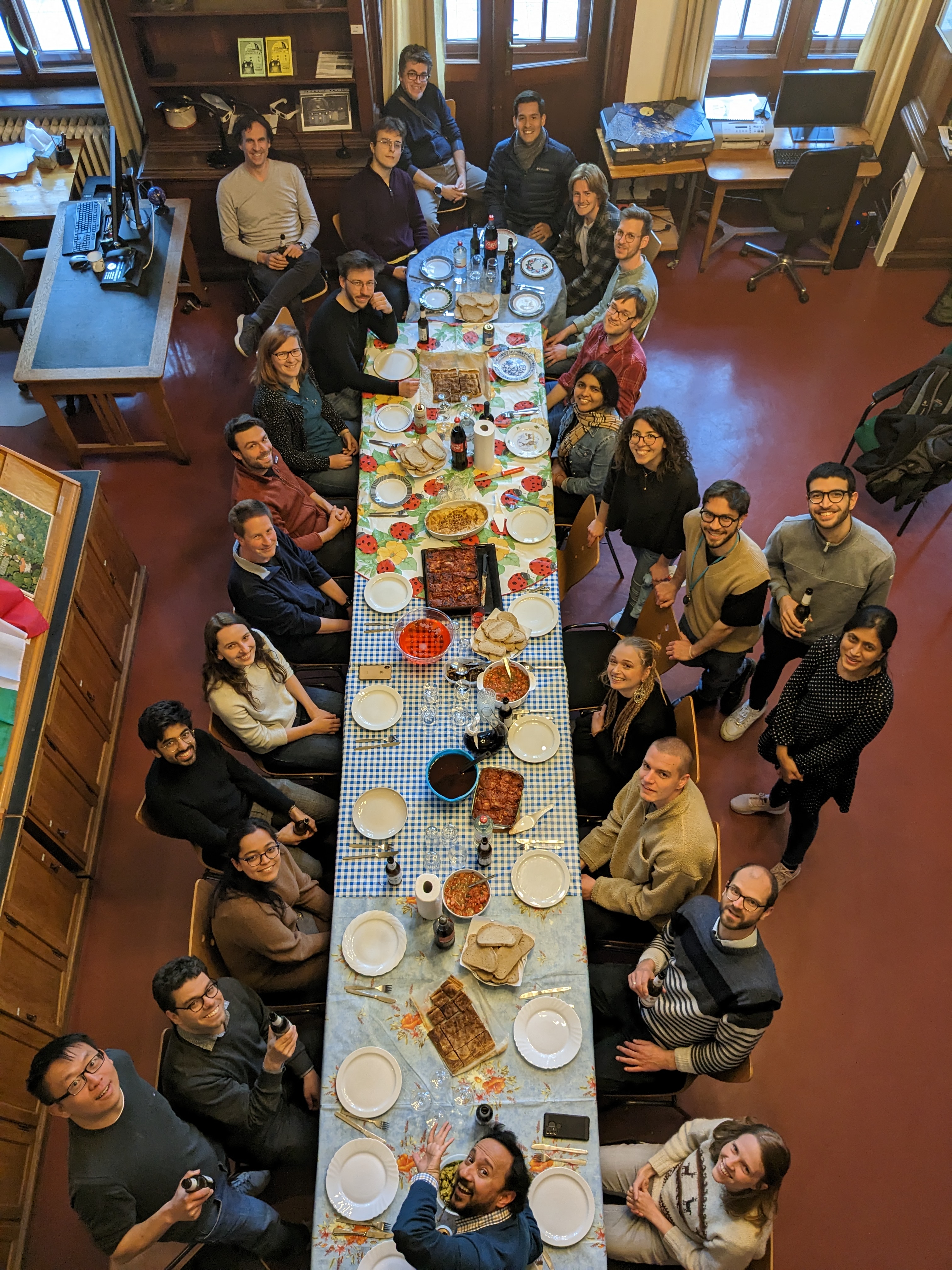
Credit: Giulia Lusetti
Theoretical astrophysics
Magnetic fields in the Universe

Magnetic fields are ubiquitous in the cosmos and are taking the center stage in astrophysical research from the smallest scales to the largest systems known in the Universe. They are responsible for stellar activity and govern the relation between planets and their host stars. Magnetic fields are essential for understanding star formation and control the density and distribution of cosmic rays in the Galaxy. On even larger scales, they affect the evolution of galaxies and galaxy clusters. The origin of these magnetic fields in individual astrophysical objects such as our Earth or the Sun as well as in the Universe as a whole is only poorly understood. Theoretical modeling of magnetic fields and their interaction with plasmas is notoriously difficult, and the observational investigation of cosmic magnetic fields remains a challenge even today. With algorithmic advances in adaptive-mesh codes, high-fidelity simulations of magnetic fields have become a reliable instrument for theory on all scales. On the observational side, a new suite of instruments are providing new measurements of and new insights into magnetic fields.

At the University of Hamburg, we have an ideal combination of researchers, from all career stages, to teach the next generation of astrophysicists how to investigate the origin and effects of astrophysical magnetic fields. We work, both, on theory and observations, ranging from stellar to cosmological scales as well as from the very lowest to the highest photon energies. We are involved in the observatories LOFAR, AUGER, CTA, CARMENES, eROSITA, and TIGRE, and have an excellent track record in cosmic-ray propagation studies and magnetohydrodynamical modeling.
Astrophysical fluid dynamics

Credit: W. Banda-Barragan
Powerful events inside galaxies drive strong winds that can expel substantial amounts of matter from the gravitational pull of the galaxy. Observations of such often spectacular events show fast winds with complex thermal structures. Outflows occur in star-forming galaxies and they play a central role in the history of galaxy formation. They are thought to cause the strong correlation between mass and metallicity observed in low-mass galaxies; they are needed to reconcile the number density of observed galaxies with the our cosmological model; and they are essential to the transport of heavy elements into the intergalactic medium. However, despite the central importance of galaxy outflows, the processes that control their evolution are extremely difficult to constrain, both, theoretically and observationally. In our work we simulate the multi-phase plasma around galaxies using supercomputer simulations. This is a formidable challenge because we have to include processes such as radiative cooling, magnetic fields, thermal conduction and cosmic rays.
Self-interacting dark matter

Credit: Fischer M. S., Durke N.-H., Hollingshausen K., Hammer C., Brüggen M., Dolag K., 2023
In our current cosmological model, ΛCDM, dark matter (DM) makes up the majority of the matter in the Universe. DM must interact gravitationally, but whether it has further interactions is unknown. In ΛCDM, one assumes that DM is collisionless. But it could be that DM has additional self-interactions beyond gravity. Such models of self-interacting dark matter (SIDM) show a different phenomenology on small scales (galactic scales) but keep the success of ΛCDM on large scales. Thus SIDM can mitigate problems or curiosities of the small-scale crisis. Moreover, SIDM is well motivated from the particle physics side and a variety of DM candidates that differ qualitatively in their phenomenology exist. We study SIDM with the help of N-body simulations. Our simulations include various setups, such as idealized mergers of galaxy clusters or full cosmological boxes. We simulate DM models that typically scatter about tiny angels and hence must interact frequently to alter the distribution of DM significantly. We call these models frequently self-interacting dark matter (fSIDM), in contrast to rarely self-interacting dark matter (rSIDM) with large scattering angles. In the paper by Fischer et al. 2021a, we have introduced the first numerical scheme that allows simulating such models from first principles. Frequent self-interactions are well motivated by particle physics, e.g. light mediator models fall into this class. Their phenomenology is particularly interesting as they can explain larger offsets between galaxies and DM in cluster mergers and suppress the abundance of satellites more strongly than rSIDM. This project is part of the cluster of excellence Quantum Universe.
Radio Astronomy
The radio astronomy group at Hamburger Sternwarte is focused on extragalactic research using the radio telescopes from around the globe, such as LOFAR, MeerKAT, ASKAP, the VLA and GMRT. In particular, we study the origin of diffuse radio emission in galaxy clusters. Among such sources are so-called radio relics and radio halos. They are produced by ultra-fast electrons in magnetic fields. Both, the origin of the fast electrons as well as the origin of the magnetic fields are not understood. Here are some recent highlights:
Gigantic radio sources discovered in the universe
An international research team led by the Observatory of Universität Hamburg has discovered four radio sources of gigantic size. These so-called Megahalos are up to ten million light years in size and could now be detected for the first time with the help of the radio telescope LOFAR. This discovery was published in the journal Nature.
Seen from a great distance, the mass in the universe is not evenly distributed, but resembles a net-like structure, the so-called cosmic web. At the nodes of the cosmic hundreds or even thousands of galaxies crowd together into clusters of galaxies. After the Big Bang, the collision of such galaxy clusters is considered one of the most powerful astronomical events ever. During such collisions, tiny charged particles are accelerated almost to the speed of light. These particles emit radio waves that can be measured with special telescopes.
Using the world’s largest radio telescope, the Low Frequency Array (LOFAR), an international team led by Dr. Virginia Cuciti and Prof. Marcus Brüggen of the Hamburg Observatory has detected four galaxy clusters surrounded by an envelope of weak radio radiation. Cuciti and colleagues have called this phenomenon “Megahalos.” They are about 30 times larger than any previously known radio sources. “We have discovered giant cosmic particle accelerators,” explains Cuciti, lead author of the study and Alexander-von-Humboldt-fellow at Universität Hamburg.
There is a high probability that the four Megahalos discovered are just the tip of the iceberg of a widespread cosmological phenomenon. This also means that further observations could reveal Megahalos in many more galaxy clusters. Megahalos suggest that most parts of the universe are filled with ultrafast electrons as well as with magnetic fields, and that there must be a mechanism to accelerate these electrons very efficiently.
LOFAR is a Europe-wide network of radio antennas, the core of which is located in the Netherlands. The telescope is designed to detect low-frequency radio waves in the 10-240 MHz range. It is operated by the Netherlands Institute for Radio Astronomy. France, Germany, Ireland, Italy, Latvia, Poland, Sweden, Bulgaria and the United Kingdom are partner countries.
Currently, LOFAR is undergoing a major upgrade to increase its sensitivity. This upgrade will allow researchers to explore the radio waves of the universe in unprecedented ways and discover more Megahalos.
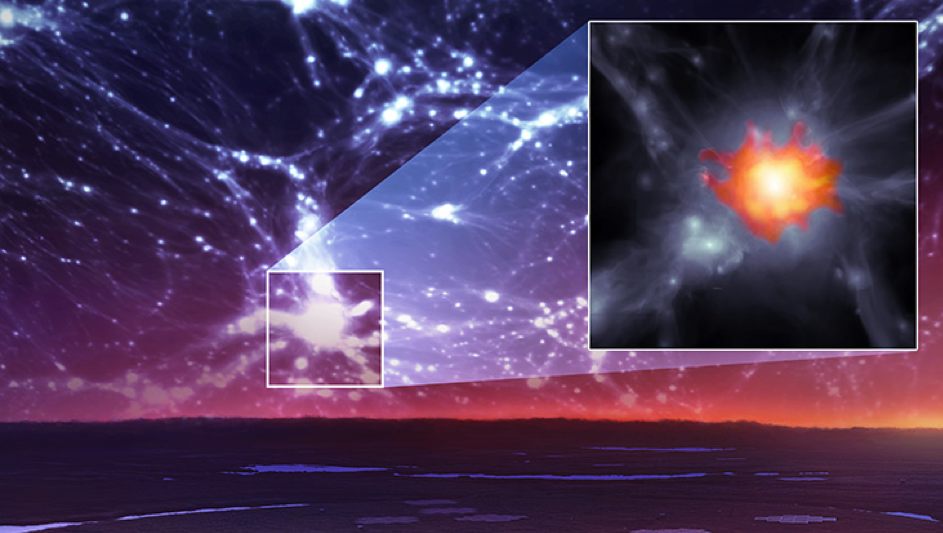
Artistic representation of the large-scale structure of the universe above the LOFAR telescope. The inset shows a magnification into a galaxy cluster where a Megahalo is observed with LOFAR. (Copyright: ASTRON/Cuciti/Vazza/Gheller).
Link to paper: Virginia Cuciti, Marcus Brüggen et al.: Galaxy clusters enveloped by vast volumes of relativistic electrons, Nature 2022, https://www.nature.com/articles/s41586-022-05149-3
The hot plasma within merging galaxy clusters is predicted to be filled with shocks and turbulence that may convert part of their kinetic energy into relativistic electrons and magnetic fields generating synchrotron radiation. Analyzing Low Frequency Array (LOFAR) observations of the galaxy cluster Abell 2255, we show evidence of radio synchrotron emission distributed over very large scales of at least 5 megaparsec. The pervasive radio emission witnesses that shocks and turbulence efficiently transfer kinetic energy into relativistic particles and magnetic fields in a region that extends up to the cluster outskirts. The strength of the emission requires a magnetic field energy density at least 100 times higher than expected from a simple compression of primordial fields, presumably implying that dynamo operates efficiently also in the cluster periphery. It also suggests that nonthermal components may contribute substantially to the pressure of the intracluster medium in the cluster periphery.
Link to paper: Magnetic fields and relativistic electrons fill entire galaxy cluster. By: Andrea Botteon, et al. In: Science Advances, 2 November 2022. Science
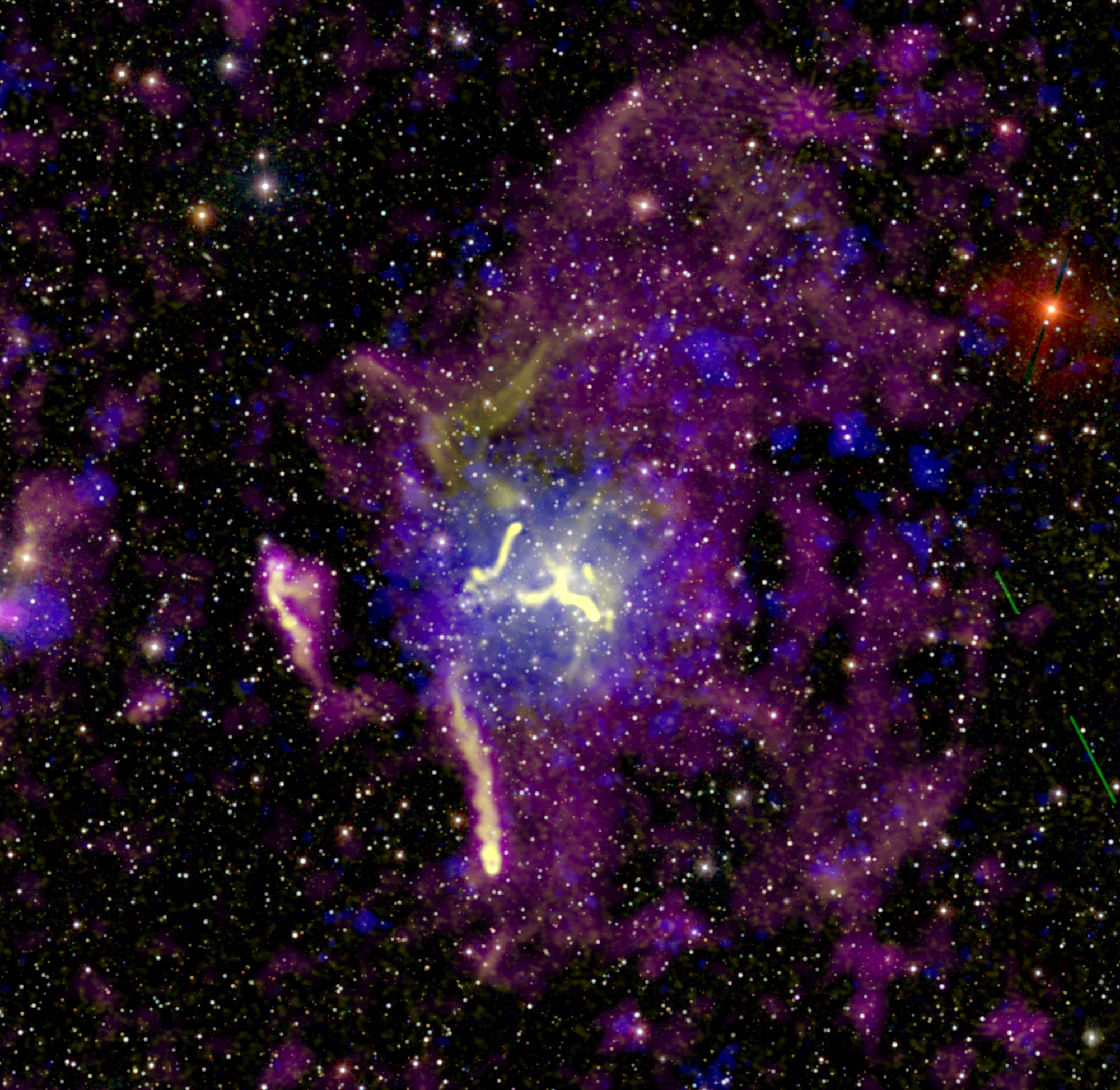
A giant galaxy
In this picture of the Abell A1132 we have discovered a giant radio galaxy that is more than 3 million light years long. It is seen in the red emission in the image below and was produced by PhD student Amanda Wilber using LOFAR and the GMRT radio telescopes.
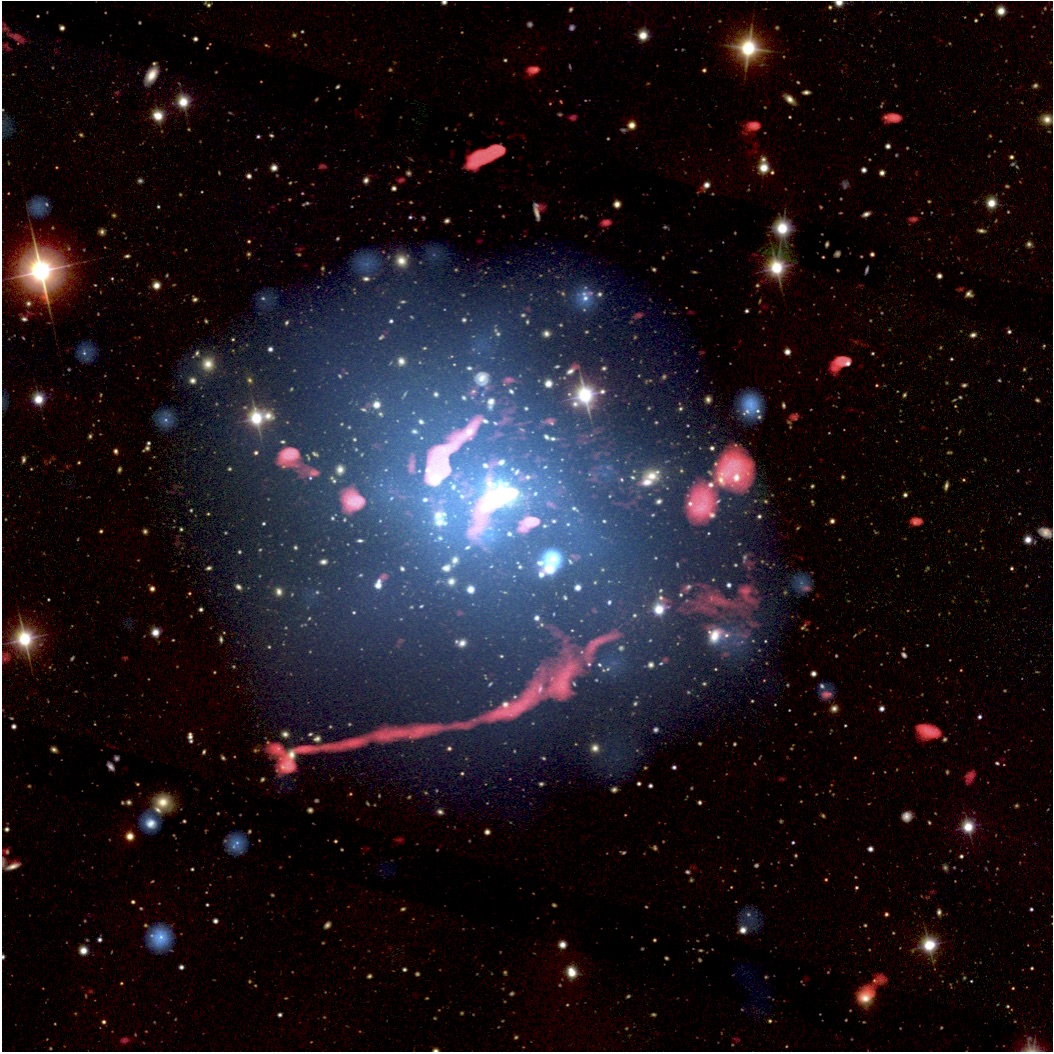
LOFAR in a Nutshell
The LOw Frequency Array, or LOFAR for short, is a digital radio telescope that spans several European countries with its core in the Netherlands. LOFAR leads the way for a new generation of digital radio interferometers that consist of a multitude of antenna fields spread over large distances. The radio waves that are received by thousands of antennae are sampled digitally, the signals are transmitted over large baselines via high-speed (10 Gb/s) fibre cables to a high-performance computing facility, where the radio images are synthesized in real time. This way, LOFAR acts like a huge digital camera that scans the entire sky in very low radio frequencies. LOFAR opens up a new window to the Universe by observing at very low radio frequencies (10 - 240 MHz). In this range of frequencies the sky is largely unexplored. Here LOFAR offers unprecedented angular resolution and sensitivity and, thus, promises new discoveries and exciting science. Moreover, LOFAR is also an important scientific and technological pathfinder for the next generation of radio telescopes, the Square Kilometre Array (SKA). The SKA will be the world's premier imaging and surveying telescope with a combination of unprecedented versatility and sensitivity that will be a ~600 Mio. Euro project.
LOFAR was developed by a consortium of institutes, universities and industrial parties, led by ASTRON, the Netherlands Institute for Radio Astronomy. The heart of LOFAR lies in the northeast of the Netherlands and spreads over several European countries. The LOFAR core has 24 stations, which are complemented by 14 remote stations in the Netherlands. Thirteen international stations in Germany (6), Poland (3), France (1), Ireland (1), Sweden (1) and United Kingdom (1) are currently operational.
With LOFAR, astronomers will get a glimpse at the epoch of formation of the very first stars in the universe, they will explore extragalactic magnetic fields, chart millions of galaxies, monitor solar activity and search for extrasolar planets.

LOFAR stations consist of fixed antennas that have no moving parts. The whole array is made up of about 51 stations, each roughly as big as a football field. Each LOFAR station has two separate arrays of antennas. These are referred to as the Low-Band Array (LBA) and High-Band Array (HBA). The LBA is optimised for the frequency range 30–80 MHz and the HBA for 120–240 MHz. The gap between the two bands is where FM radio is broadcast. Phased arrays such LOFAR work by exploiting the physical effects of constructive and destructive interference. By adding phase delays between the signals received at every single antenna, the telescope can me made most sensitive in on particular direction of the sky. This so-called beam can be steered electronically across the sky. The signals from all station are "synthesized" into images in one big supercomputer that is located in Groningen (NL).
In collaboration with the University of Bielefeld, Hamburger Sternwarte constructed a LOFAR Station in Norderstedt, close to the City of Hamburg, which is in operation since 2015 (open pull-down menu below for more information).
LOFAR in Hamburg
The LOFAR station DE 609 in Norderstedt is the sixth German station, which came into operation in 2015. The station is owned by the Universities of Hamburg and Bielefeld and is part of a network of more than 50 similar stations spread over Europe. The network forms the International LOFAR Telescope (ILT), which is operated by the radio observatory ASTRON in the Netherlands on behalf of all partners of the ILT. The ILT is used to make images at radio frequencies. Being owner of a station the research groups in Bielefeld and Hamburg have privileged access to these images.

The hardware of the stations is mechanically relatively simple and inexpensive to set up. The innovation lies with the requirements for data transmission and with signal processing in the central supercomputer system in Groningen. The optical fibers have to transport several gigabit of data per second and the computer has to process the data from all stations in real time. And this 24 hours in seven days a week. LOFAR is therefore a real child of today's digital age.

The radio signals coming from the sky are extremely weak. In order to detect them, the radio emission generated by humans have to be filtered out. Radio waves are used for example for the transmission of radio and television and for mobile phones. As little radio radiation as possible should be generated in the vicinity of the LOFAR stations. The station antennas have the sole task of listening into space and do not emit any signals themselves. Except during occasional repair and maintenance work, the station, which is surrounded by a wooden fence, measures fully automatically without human presence. Visitors are welcome: There are two information boards that provide information about LOFAR at the entrance to the station. Video surveillance is made continuously for safety reasons.
DE 609 Norderstedt WebCams
LOFAR Station Norderstedt of the Universities Hamburg and Bielefeld is located at Harthagen street in Norderstedt, a town north of Hamburg. The station's coordinates are 53° 41' 55.1" North, and 9° 58' 10.4" East. Two public displays located near the entrance gate provide information for visitors. For security reasons the station is monitored by a CCTV system.
DE 609 images shown below are updated every few minutes.
| Low Band Antennas | |
| High Band Antennas | |
| Gate |
Machine learning
Machine learning techniques that perform morphological classification of astronomical sources often suffer from a scarcity of labelled training data. We work on supervised deep learning models for the morphological classification of radio galaxies, which is particularly topical for the forthcoming large radio surveys, e.g. by the LOFAR. We demonstrate the use of generative models, specifically Wasserstein GANs (wGANs), to generate data for different classes of radio galaxies.
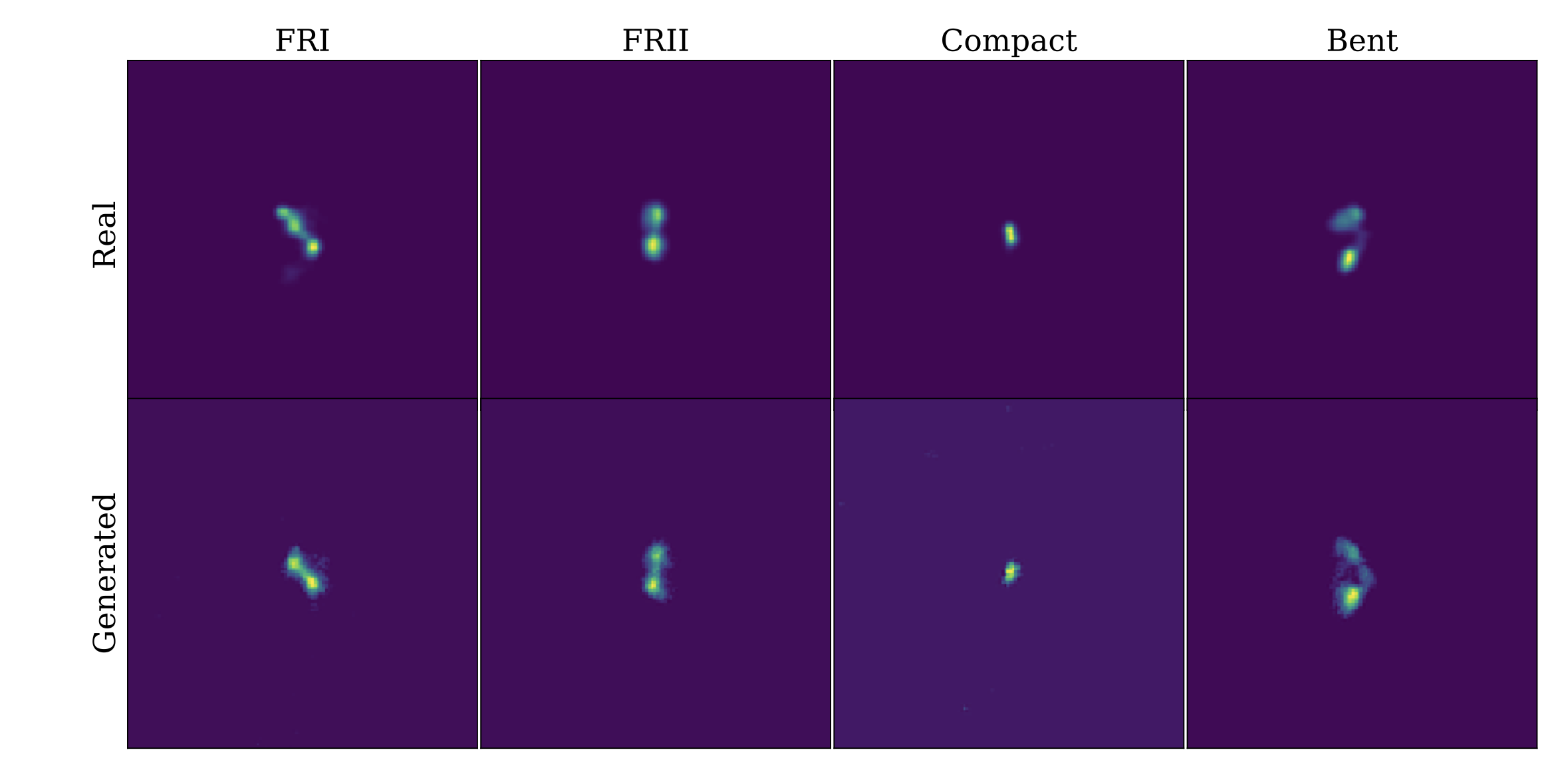
Furthermore, we participate in SKA data challenges and work on anomaly detection and automatic classification of image data.
Radionets
Our project, “radionets”, in collaboration with the TU Dortmund, is an open-source framework for training deep-learning models applicable to radio interferometer data in Python. Besides model training routines, different simulation techniques are available to create training and test data sets. A collection of evaluation techniques enables assessing the model's reconstruction quality. The complete workflow of the framework is illustrated in the following figures:

Publication: K. Schmidt et al. 2022: Deep learning-based imaging in radio interferometry
